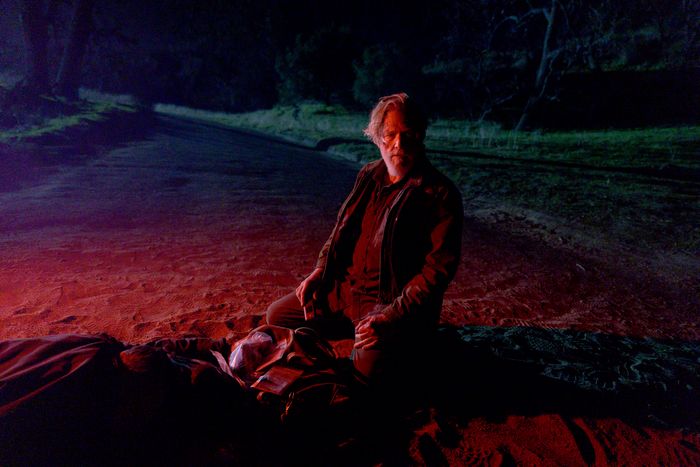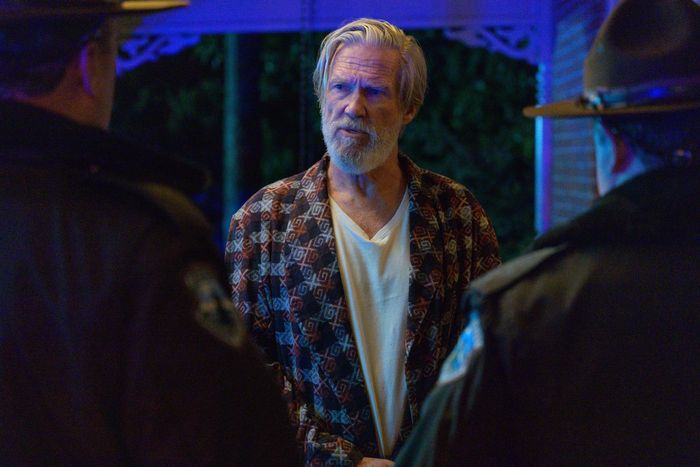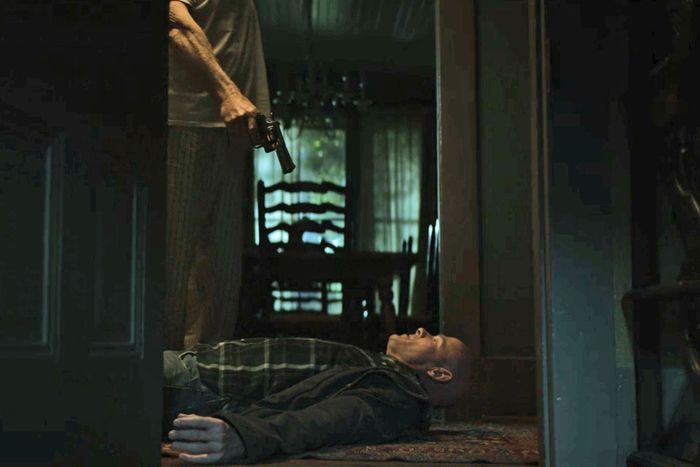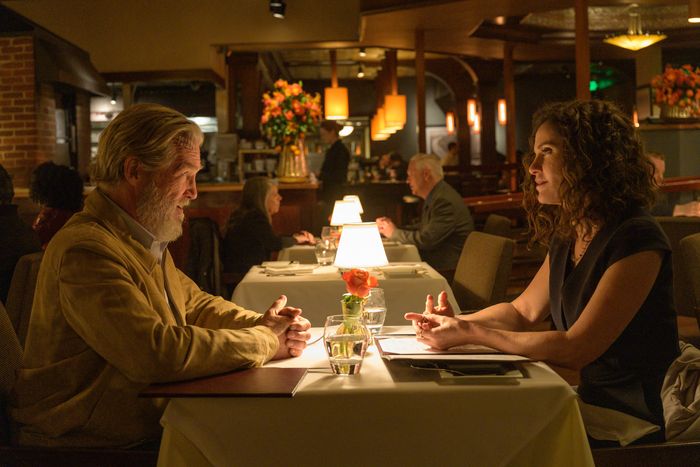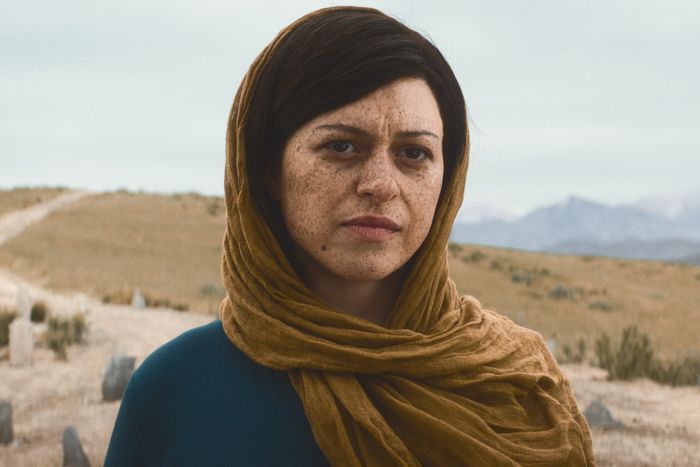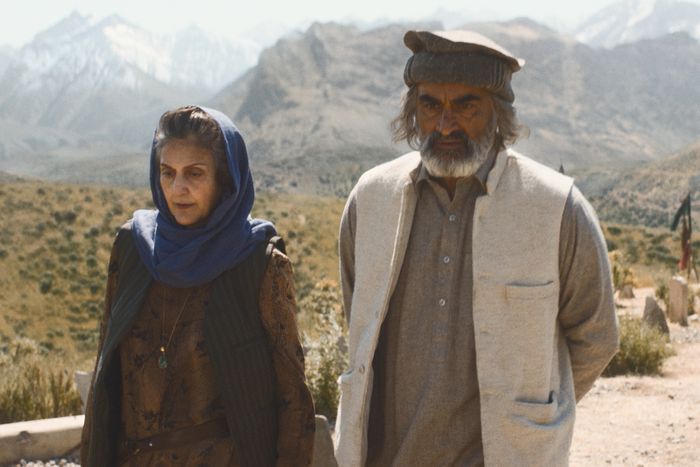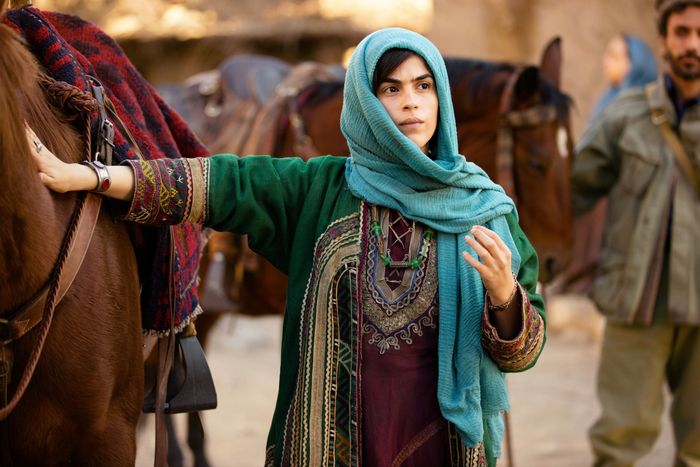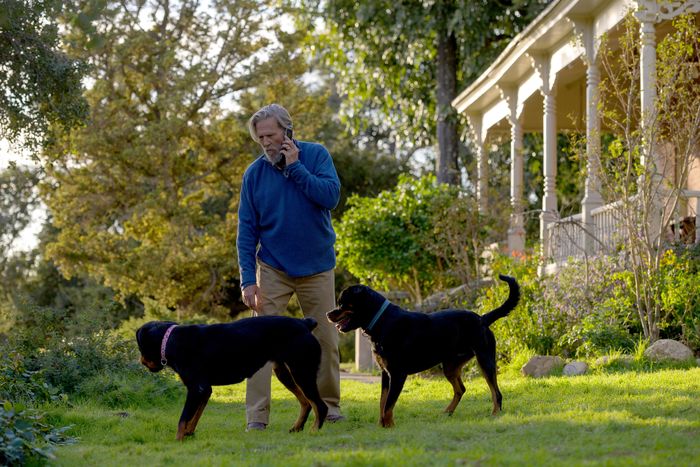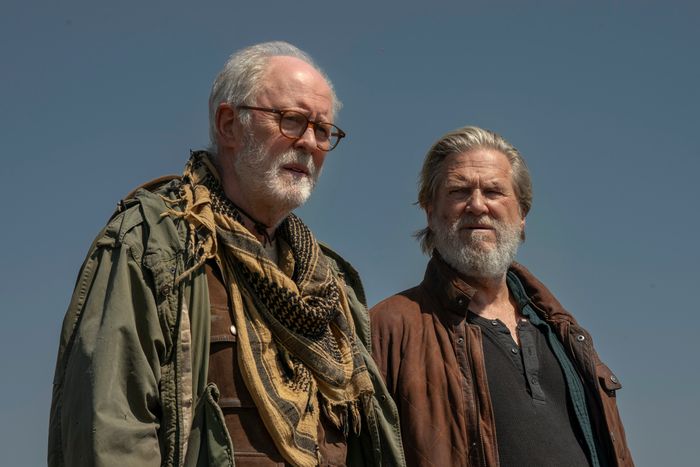
Do you groan when you stand up from your couch? Then you’ll feel a kinship with The Old Man, the painterly FX spy thriller returning for a second season this week. Created by Jonathan E. Steinberg and Robert Levine, the series revolves around Dan Chase (Jeff Bridges), a former CIA operative who’s on the other side of what seems to be a happy family life and mourning the death of his wife, Abbey (Hiam Abbass), when a not-so-happy chapter of his violent past breaks into his house and tries to kill him. The encounter yanks him back into the shadowy world of international intrigue, where he’s reunited with an old handler, Harold Harper (John Lithgow), while his daughter, Emily (Alia Shawkat), and a civilian, Zoe McDonald (Amy Brenneman), eventually factor into the mix. You know, classic spy stuff.
Things quickly get much less traditional, though, as The Old Man grows more ornate with each episode. As the first season unfolds, we learn that Emily has a second identity as an FBI agent named Angela Adams in addition to being the secret biological daughter of an Afghan warlord, Faraz Hamzad (Navid Negahban), who is locked in a blood feud with Chase for betraying his trust and, well, absconding with both his wife and daughter many decades ago. Complications, conspiracies, and cool fights pile on, and by the first season finale, both Chase and Harper depart for Afghanistan to find Emily/Angela, who had taken off on her own to hunt down answers about her past.
The Old Man is a strange show. On one level, it’s basically a soap opera with old men and guns, but it makes too many bold, interesting choices to ever be called conventional. Whether it works for you really comes down to whether you vibrate at its frequency, and though the second season is broadly weaker than the first — trading the tautness of the opening stretch for increasingly unwieldy melodrama — the show’s unique qualities are still on full display. Here, an appreciation of the stylistic and storytelling idiosyncrasies that make it much more than another by-the-numbers spy thriller.
Textural Weirdness
Watching The Old Man can be a discombobulating experience. The dialogue is stilted, as is its general delivery, which seems to be going for a sense that every major character is struggling to contain about 50,000 emotions boiling within. The show has this quality where it occasionally feels it’s been adapted to Swedish and then back into English again. Its tenor swings wildly between a gritty FX-elevated take on the spy thriller and a grand family epic, dealing with choices made in the twilight of your life and the dubiousness of American foreign policy. In places, the show can feel agonizingly slow and laconic; then you blink and realize so many plot developments and revelations have skated by that you’re practically watching a different program.
At some point, you might start to wonder, Is this a bad show? But then The Old Man hits you with another array of fun, textured details — Chase putting butter in his coffee, Zoe’s gorgeous woodland house, the sickly yellow glow of the FBI offices — and you instead get the impression that every choice in this series is intended to produce a very specific frequency. The Old Man is what you might call a cilantro show, and if its particular taste hits you right, there’s something undeniably potent about the way the whole thing comes together. — Nicholas Quah
Glorious Speechifying
The Old Man’s most defining feature — even more so than those long action takes, Lithgow’s little frown, and Bridges’s exhausted grunting — is the monologuing. Oh, the monologuing! If you missed Don Draper’s product pitches on Mad Men or Elliot Alderson’s internal arguments on Mr. Robot, The Old Man will fill the loquaciousness-loving hole in your heart. This series is gloriously talky, and that’s because The Old Man is ultimately less interested in what Chase, Hamzad, and Harper are up to than why, and the series’ allowance for layers of characterization and motivation keep it from becoming another predictable espionage show.
In both its first and second seasons, The Old Man is committed to analyzing why we tell stories and how we use them to make ourselves feel better, even after doing something as insane as kidnapping another man’s daughter and raising her as your own (Chase), or engaging in a massive government cover-up (Harper), or traveling across the world to meet a man you don’t know for answers about the mother you didn’t really know, either (Emily). That high-mindedness is an asset when you have actors as solid as Bridges, Lithgow, and Shawkat doing the monologuing, and although Abbass is very missed in the second season, Negahban gets more to do as the elderly and exhausted Hamzad. That’s one great actor for another; I will accept this trade. — Roxana Hadadi
Being Old Is Tough …
It’s nice to watch an action-packed series featuring an old man that approaches the age of its protagonist less as a joke and more as a natural condition of the world, like the weather. As Dan Chase, Bridges seems so comfortable displaying his septuagenarian-ness on the screen: He groans, his legs shuffle along as if they audibly creak, and his mouth even does that thing I’ve only seen men in their 70s do, where it always looks mildly agape. Sure, we do get to points where it starts to beggar belief that Chase can endure the sort of physical stress that even a 30-year-old might need months to recover from, but, hey, it’s a TV show. This isn’t to say that The Old Man doesn’t lean into the comedy of age when the right opportunity presents itself: There’s a bit early in the second season where Lithgow’s Harper has to stop often to relieve himself, which is a tough and dangerous thing to do when you’re traipsing through hostile territory in the Afghan desert. But the show keeps a light touch with this stuff, which is nice. — NQ
… But Also Kind of Badass …
There are some fabulously tactile action sequences on The Old Man that are truly thrilling to watch. The pilot opens with two standout set pieces underscoring its particular style: the home invasion that catalyzes the events of the series and a car chase that concludes with a brutal scuffle. Both display the show’s signature penchant for drawing out the physical action to near-ludicrous lengths while draping those scenes with moody atmospherics. The home invasion is shot almost purely in shadow. (See above.) Meanwhile, the fight at the end of the car chase is bathed in the red of the vehicle’s brake light as we watch Chase manually grappling with his younger assailants for extensive, exhausting stretches. It’s striking to see Bridges convincingly pull off these physical battles, made more remarkable knowing the actor was in the midst of a yearslong battle with non-Hodgkin’s lymphoma during filming; Bridges was also hospitalized after he contracted COVID while undergoing chemotherapy during production of the first season. “I was kind of surrendering to the idea that I might die,” he told Variety in 2022 of his experience. He returned to set after five months, and it remains haunting to watch the first season with that detail sitting in the back of your head. The second season still gives Bridges a fair bit of fighting to do, though those sequences are a little tighter and not as drawn out. Not that it makes them any less impressive. — NQ
… and Sweet
For all its stoic action and geopolitical intrigue, The Old Man also leaves room for a sweet relationship to develop between Chase and Zoe McDonald (Amy Brenneman), a woman he ends up drawing into his world by accident. What can I say; I’m a sucker for TV shows and movies that explore romance between older people. Sure, The Old Man doesn’t break all that much ground with the pairing — Zoe isn’t ultimately given all that much to do, and there’s a lot of Chase going “you don’t want any part of this manly, violent life” — but Bridges and Brenneman have a really nice chemistry that adds balance to a show that always threatens to tip into excessively morose. — NQ
Women!!!
Yes, that’s meant to be read in a triumphant Saoirse Ronan–style way, because The Old Man is full of moments that make me fist pump like I’m watching Jo March puncture assumptions about the “gentler sex.” So much so that the series’ name almost feels like a fake-out, because it’s really the women of this series who keep its narrative momentum going. The first season was wonderfully methodical in how it unfurled Abbey in the recent and far past, and it gave time to Abbass as Abbey and Leem Lubany as the younger version of her, born Belour Hamzad, to run scheming circles around the men in the character’s life. Similarly solid was Shawkat, who had to walk the line between her Emily Chase and Angela Adams identities and effectively conveyed a woman losing herself in two separate lives. It’s unfortunate that Abbass — who spent the latter half of season one haunting her husband and daughter through (of course) monologues — isn’t around in the first five episodes of season two that were provided for review. But Shawkat gets a meaty character turn, and Jacqueline Antaramian does solid supporting work as one of Hamzad’s trusted advisers, and the two offer a different perspective on Afghan women than what American media normally presents. — RH
Heroes Who Are Also Villains, Villains Who Are Also Heroes
The Old Man doesn’t allow for flat characterizations. Chase and Harper are “good” men who do bad things; Abbey was a damsel in distress who revealed herself to be a femme fatale; Hamzad is an Afghan warlord turned monstrous because of a broken heart caused by those very same “good” men and damsel in distress. Yes, this is typical anti-hero stuff; The Old Man didn’t invent the prestige drama. But let’s be frank: It’s rare to see a series in this mold be so emotionally generous to its Middle Eastern characters. The Old Man is specifically engineered to help you understand everyone’s point of view, so when you listen to Hamzad’s mournful soliloquy about the daughter that was taken from him and the decades he’s spent agonizing over her absence from his life, you understand both his pain and why his wife thought absconding with their child was her only option. That singular title doesn’t preclude there being more than one old man in this show dealing with regret over the spy game at the same time, and that’s inclusivity! — RH
A Depiction of American Foreign Policy That Doesn’t Make Me Want to Groan (Yet)
This is connected to the show’s characterizations in that while The Old Man is about political agendas and international warfare — in particular, the Soviet invasion of Afghanistan in the first season and American support of the Afghan resistance effort against the Taliban in its second season — it’s not doing an “all Americans good, all Afghans bad” thing. There’s no moment in either season when The Old Man seems to be blindly advocating for interventionism; everything that happens as a result of Chase and Harper being stationed in Afghanistan is pretty fraught. And in both the present and past story lines, different Afghan factions have different agendas, different ideologies, and different lifestyles; they’re not immediately labeled as terrorists or written off as zealots. In fact, the series’ strongest bit of world-building may be Hamzad’s compound, a place that was a prison for someone like Belour, who long before marrying Hamzad had decided America would be her future, but was a refuge for Hamzad’s female relatives, whom he elevates to positions of power and trusts to strategize and advocate on his behalf against the Taliban. The fact that The Old Man has, up until this point, treated this part of the world with complexity and nuance instead of painting it with a broadly Islamophobic brush is a relief. — RH
The Opening Illustrations
Another place where The Old Man casts a gratifyingly nuanced eye toward the region it uses as its sandbox is the opening imagery by British Iranian artist Hana Shahnavaz. Shahnavaz’s specialty is paintings inspired by Iranian stories, and the unique stills she’s created for each episode, done in the style of Persian miniatures, are beautiful, colorful, and detailed. The images depict jackals, inspired by the titular characters from a book of second-century fables, Kalīlah and Dimnah, on an epic journey: Underneath trees, amid flowers, and framed by geometric patterns customary to Islamic art, they face off against scorpions, are guided forward by hawks, and peer into caves. Shahnavaz has said that the series’ producers asked her to hide clues in the miniatures, and you can pore over them for insights if you want. But even if you don’t treat the illustrations like a puzzle box, they’re a pleasing way to start off each episode. — RH
The Good Boy and Girl
The Old Man also happens to feature Dave and Carol, Chase’s two very cool dogs whom he brings everywhere in the first season and who serve as his guardians against all sorts of baddies. (We’re big fans over here.) They’re a little less present at the outset of the second season, but don’t worry: They return soon enough. — NQ


